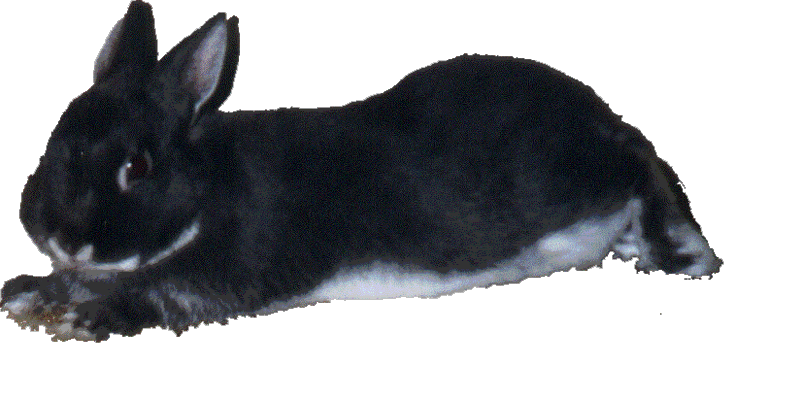
Rabbits cannot survive in temperatures over 28° Celsius, and bunnies are highly susceptible to
heat stroke. Thus, if your bunny lives outdoors, they should always have some shelter away from
direct sunlight - but why not keep bunny indoors with you? Particularly here in Australia, where
even the southern states bake under 30°C or even 40°C days during summer.
The symptoms of heat stroke are obvious and distressing - a bunny suffering heat stroke will
pant (bunnies never mouth-breathe except when in severe respiratory distress), and may stretch
out in an attempt to cool his body, and will often be limp and floppy. Unless treated immediately,
and removed from such a hot environment, he will become dizzy, uncoordinated, and might go into
convulsions. A rabbit with such advanced symptoms of unconsciousness or convulsions is most
certainly near death. Seek veterinary help immediately if the rabbit is unconscious or convulsing -
he may need intravenous fluids to stop him dying from shock. Heat stroke is
a very dangerous condition indeed, which can be fatal or permanently damaging, and you must treat
any bunny showing early symptoms of heatstroke, such as panting and limpness, sure signs of
heatstroke when combined with an overheated environment, immediately:
Immediate treatment
involves cooling bunny’s body temperature, with tepid, room-temperature
water (never use cold water - this sudden cold can put a rabbit into shock - always make sure
it’s room-temperature water - judge the temperature of the water by putting it on our own skin
the way you would with water for a baby). Douse your bunny with this tepid water by using a
saturated towel, or repeatedly dipping your hands in the water and using your very wet hands
to massage the water into bunny’s fur and skin. You can spray or flick the water gently over
bunny, and continue massaging the water into his fur, all over, including his back and his
tummy, via your wet hands.
Offer a bunny in this state soft food, such as slices of apple or banana, and be sure to have
water within easy access of bunny at all times. An unresponsive rabbit can also be fed water
through a plastic syringe (no needle of course), very slowly into the side of his mouth, just
behind his large front teeth. The most important thing, though, is to keep his body temperature
down by massaging tepid water into his fur. Continue dousing, massaging or rubbing water into
his fur and skin, and even rubbing your wet hands onto the fur of his ears, because of
course this is the same as for humans ... if your skin is wet, it feels cooler and cools your body
temperature down - as with us, if you keep his skin moist, the evaporation of this water on his
skin will cool him.
Another trick we learnt from rabbit hobby breeders … particularly throughout the harsh Australian
summer, many of the breeders freeze a soft-drink-bottle full of water, and then put that in
their bunny cages - their bunnies then lean against it and keep their body cool (sort of like
the reverse of a hot water bottle!). Unfortunately, however, this never worked successfully with
our beautiful bunny Dasher, because he kept trying to chew the bottle, so we had to take it away!
Try it if you like, but keep a close and continual eye on your bunny when you try it, and make
sure he doesn’t chew the bottle ... if he were to ingest plastic, he could get a stomach blockage,
which would be an even bigger problem.
Another alternative is to use a hard tupperware container, particularly those hard-plastic square
containers/bottles, which won’t roll around as much as a round bottle - the hard plastic is a
little safer, but nevertheless, be sure to keep an eye that your bunns don't chew them, still.
We know some people who use a big piece of tiling, too - they put it in their fridge to make it
cool, and then put it where their bunns can lay against it.
Another really good idea, which we’ve heard from bunny-friends but haven't tried ourselves
yet, is to drench a towel with cool water, then ring it out so that it’s just this side of
not-dripping wet, and drape it over your bunn’s hutch/cage - apparently this creates a moist,
cool microclimate for him.
And spare a thought to your bunny’s cage placement within your room ... when it’s very warm,
closer to the floor of a room is usually cooler than up on a table - the floor is the
coolest place to put his cage, especially if the floor is nice cool concrete or wood.
Even after your bunny’s body temperature has cooled, and he has ceased panting, you will
need to keep a good eye on him - if he has suffered heat stroke once, he will be more susceptible
to it in future, particularly over the next few days. Especially keep an eye on him, and keep
him cool with tepid water massaged into his fur, if you think he is beginning to get overheated,
during those few really hot summer days here in Australia.



